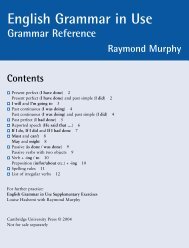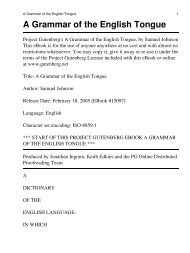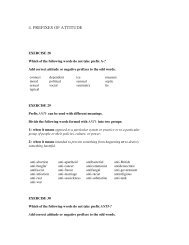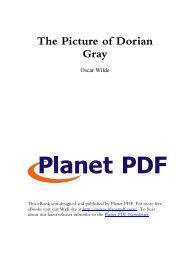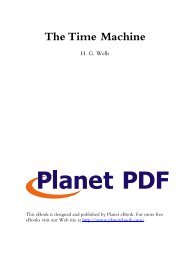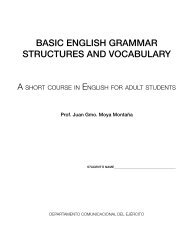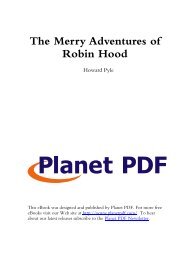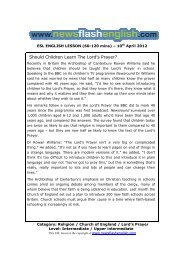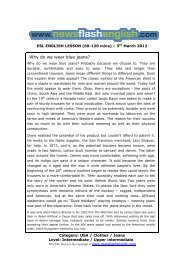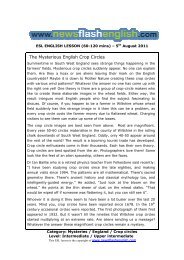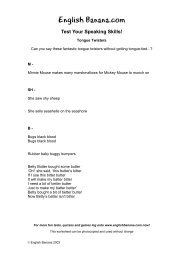TO DOWNLOAD - 75 Pages (928kb - PDF format) - ESL Teachers ...
TO DOWNLOAD - 75 Pages (928kb - PDF format) - ESL Teachers ...
TO DOWNLOAD - 75 Pages (928kb - PDF format) - ESL Teachers ...
Create successful ePaper yourself
Turn your PDF publications into a flip-book with our unique Google optimized e-Paper software.
RHE<strong>TO</strong>RICAL SKILLS^34D CMS documentationThe fourteenth edition of The Chicago Manual of Style(1993) covers two methods of documentation exhaustively;the method discussed in this manual is known as"Chicago style," and has long been used in history aswell as other realms of the arts and humanities. Its useof superscripts is somewhat bothersome to writers, but ithas some advantages, the main one being that the superscriptshinder and detract less from the text than parentheticalreferences. In addition to the Chicago Manualmentioned above, consult Kate L. Turabian's A Manualfor Writers of Terms Papers, Theses, and Dissertations,6th Edition (1996) for further reference.MARKING IN-TEXT CITATIONSThe Chicago Manual of Style employs traditional superscriptarabic numerals or raised arabic numerals withinthe text (in this fashion 12 ) and footnotes placed at the bottomsof pages on which their corresponding superscriptnumerals appear.• Sometimes, instructors ask their students to place allnotes in an Endnotes section at the end of the paper.You should be sure which of the alternatives yourinstructor wants you to use.• Sometimes, too, you are instructed to write a separateBibliography page at the end of the paper on which allsources are arranged alphabetically.• You should number all notes consecutively throughoutthe paper,• Place your superscripts slightly above the line (like this 7 )they should occur immediately after quotations or paraphrases(without a space). Do not put the superscriptnote numbers before periods, parentheses, brackets, orslash marks; the superscript number follows any punctuationexcept the dash, and it is always put outside aclosing parentheses.• A superscript numeral in your paper means that a quotation,idea, paraphrase, summary, or statistic has beenborrowed from a secondary source; to find the author orpublishing details for the source, the reader only has tocheck the footnote with the same number on the samepage (or endnote if you list all your notes on a page atthe end of your paper) for the in<strong>format</strong>ion.•Avoid the overuse of superscripts. When possible,incorporate your in<strong>format</strong>ion in the explanatory andsupporting material of your paper.EXAMPLES:Of a superscript numeral in the paper:Carl Resener categorizes the homeless accordingto the reasons for their displacement: the"Seeker," the "Mentally III/' "the Stranded/' andthe "Self-inflicted." 2Of a footnote or endnote:: Carl R. Resener, Crisis in the Streets (Nashville:Broadman Press, 1988), 66.CONVENTIONS FOR NOTESChicago Manual guidelines for preparation of footnotesor endnotes are clear and direct, and must be followedscrupulously:• The first time you refer to a citation in the notes, give acomplete entry in the correct <strong>format</strong> for the bibliographicalstyle you are employing in the paper; afterwards,use the last name of the author and a pagenumber (subsequent references should include onlyenough in<strong>format</strong>ion to allow the reader to locate theoriginal note or bibliographical entry).•Begin with the Arabic numeral corresponding to thenumber of the citation in the text. Follow the numberwith a period and one space.• Insert a space between entries. Single space all lines ofan entry.•Indent the first line of an entry five spaces (one-halfinch) and place successive lines flush left.• Each first entry of a book reference should have the followingin<strong>format</strong>ion (choose what is applicable to thebook you are citing):Complete name of the author in first-name last-nameorder;Title of the book and subtitle, underlined or italicized;Name of editor, compiler, or translator, if any, precededby ed., trans, or comp.;Number of name of edition, if different from the first;Name of series in which book appears, if any, withvolume or number in the series;Within parentheses: the city of publication followedby a colon, the publisher's name followed by acomma, and the date of publication;The page number(s) on which the cited in<strong>format</strong>ioncan be found, followed by a period.•In note references, the items above are separated bycommas, or, as in the facts of publication (city of publication,publisher's name, and date of publication),parentheses. Do not place a comma just before theopening parenthesis of the publication facts; however,do place a comma just after the closing parenthesisof the publication facts, before the reference to pagenumber(s).•In general, all items within the notes are separated byone space.• Underline the titles of books, plays, long poems, pamphlets,periodicals, films as long as they are publishedas independent, separate works.• If the tide of a book you are citing includes the title ofanother book, as in A Resource Book for JosephConrad's Lord Jim, underline the main title, but do notunderline the included title.•Use quotation marks for articles, shorter titles, songtitles, and unpublished works.67




